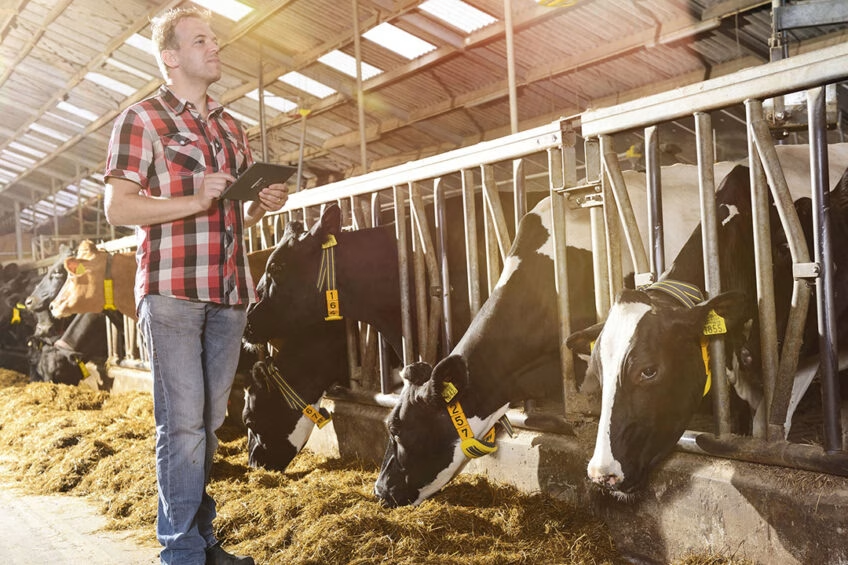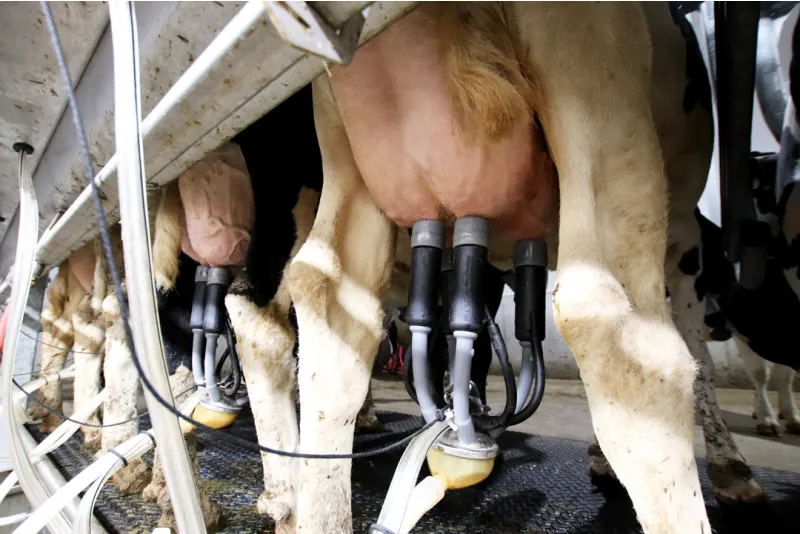Prepare to be amazed by the U.S. dairy cows breaking and shattering milk production records. Curious about their secrets and what it means for global demand? Keep reading.
Summary: Have you ever been intrigued by the fierce competition among top-producing states in the U.S. dairy industry? This competition has led to a significant increase in milk production, with the average U.S. milk cow producing 63% more milk in 2023 than in 1990. Michigan, a key player in this competition, leads in efficiency. The U.S. dairy industry has become a global powerhouse, with increased per-cow output and butterfat levels. Over the past decade, U.S. dairy cows saw per cow output rise by 11%, from 21,722 lbs. in 2013 to 24,117 lbs. in 2023. Michigan tops the nation, producing 27,564 lbs. of milk per cow per year, an 81% increase since 1990. Advanced technology, genetic selection, and artificial insemination have led to healthier cows producing more milk, driving cash revenues to an expected $42 billion in 2022, up from $35 billion in 2013.
- Michigan leads the nation in milk production per cow, with an 81% increase since 1990.
- The average U.S. milk cow produced 63% more milk in 2023 compared to 1990.
- Butterfat levels in U.S. milk have significantly improved, contributing to increased dairy output.
- Top-producing states include Texas, New York, Wisconsin, and Idaho, with Texas leading in 2023.
- Advanced technology, genetic selection, and artificial insemination are critical drivers of increased efficiency.
- U.S. dairy cows saw an 11% rise in per-cow output over the past decade.
- The U.S. dairy industry’s efficiency has made it a global powerhouse, with notable increases in cash revenues.

Over the past decade, the U.S. dairy industry has experienced a significant surge in milk production, marking a period of remarkable growth and transformation. Dairy cows have broken new milk production records, with the per-cow output increasing by an impressive 11%, from 21,722 lbs. in 2013 to 24,117 lbs. in 2023. This surge in production is not limited to the quantity of milk. Butterfat production in the United States has also seen a substantial increase of 23%, with the average butterfat content rising from 3.76% in 2013 to 4.11% in 2023. These consistent advances in efficiency have resulted in the typical U.S. milk cow producing 63% more milk in 2023 than in 1990. This unprecedented growth underscores the transformation of U.S. dairy farming, making our cows some of the most productive in the world. But what is the key to these extraordinary accomplishments, and how have American dairy producers remained ahead of global competition? Let’s delve into this record-breaking trend and explore the methods that produce these incredible outcomes.
| Location | Average Milk Yield per Cow (lbs.) | % Increase Since 1990 |
|---|---|---|
| Michigan | 27,564 | 81% |
| Wyoming | 26,000 | 100% |
| Colorado | 24,000 | 51% |
| Texas | 25,500 | 70% |
| Wisconsin | 25,400 | 65% |
| Canada | 23,900 | Not Available |
| United Kingdom | 19,000 | Not Available |
| Argentina | 17,000 | Not Available |
| European Union | 16,000 | Not Available |
| China | 11,000 | Not Available |
| New Zealand | 10,000 | Not Available |
The Golden Era of U.S. Dairy Farming: A Decade of Unparalleled Efficiency
The last decade has been nothing short of transformative, inspiring American dairy producers to reach new heights of efficiency. Have you ever wondered how much more efficient contemporary dairy farming has become? Let’s look at some incredible data demonstrating the nationwide growth in milk production efficiency.
In only ten years, per-cow milk production increased by 11%, with the typical dairy cow producing 24,117 pounds of milk in 2023, up from 21,722 in 2013. Such significant increases do not end there. The fat content of milk—an important indication of quality—has also increased significantly. The average butterfat level in U.S. milk grew from 3.76% in 2013 to 4.11% in 2023, representing a 23% increase in total butterfat production.
Think about it. What exactly does this imply for the industry? This means that dairy producers may now produce more and higher-quality milk with fewer cows using innovative procedures and technologies created and perfected over time. These numbers highlight a remarkable trend of increased efficiency and production, establishing a new standard for dairy farming throughout the globe.
State-by-State Breakdown: The Top Performers in Milk Production
Let’s look at the top milk producers in each state. Michigan has taken the top rank in terms of production. Michigan’s dairy cows produce an astonishing 27,564 pounds of milk per cow per year, representing an 81% increase since 1990. This gigantic tower exemplifies the state’s continuous pursuit of efficiency.
Wyoming is just a little behind, and it is also seeing remarkable development. Despite being a minor player, Wyoming’s handful of dairy cattle have improved their game by more than tripling their milk supply since 1990, achieving second place. Colorado isn’t slacking either; the state ranked third with a 51% increase in milk output over the same time.
The battle for fourth place is fierce among several central dairy states. Texas, for example, leads with yields surprisingly close to those of other heavyweights like New York, Wisconsin, and Idaho, averaging roughly 25,500 pounds per cow annually. However, the Lone Star State edged the competition to take the top spot in 2023.
Each state provides something unique, yet all are dedicated to pushing the limits of dairy efficiency. These states are boosting the dairy business in the United States to new heights by combining innovation, innovative technology, and a never-ending pursuit of progress.
How Do U.S. Dairy Farms Stack Up Against Their International Counterparts?
How do U.S. dairy farms compare to their overseas counterparts? Let’s look at the data to discover why milk production in the United States is the industry gold standard.
Dairy cows in the United States are outperforming all other countries regarding milk production. In 2023, cows in the United States produced an average of 24,117 pounds of milk each year. In contrast, Canadian dairy cows generated 3% less milk while being the second most efficient globally. This implies that each cow in the United States produced around 724 pounds of extra milk yearly.
Looking farther out, the margin of advantage becomes much more enormous. The United Kingdom ranked third, behind by a considerable 24%, implying that its cows generated around 5,788 lbs. less milk per head. Argentina has significantly lower yields, behind the United States by 30%. Argentine cows generate around 7,235 kg. Less milk is produced per cow each year.
The European Union, a significant participant in the global dairy market, also lagged. With 34% lower yields than U.S. cows, this equates to an annual deficit of around 8,200 pounds per cow. Moving to Asia, China’s dairy farming innovations have yet to overcome the gap; their outputs still fall short of what American cows generated in 1990. This reflects the United States’ longtime leadership in efficient milk production.
Finally, consider New Zealand, which is known for its dairy exports. Despite worldwide renown, New Zealand’s milk per cow fell 59% behind the United States. That’s a stunning discrepancy, meaning that New Zealand cows generated roughly 14,235 pounds less milk each cow each year.
These figures show that American dairy farms are competing and improving milk production efficiency. This unprecedented productivity enables U.S. farmers to supply local and worldwide dairy demand successfully.
Ever Wondered What’s Behind This Surge in Efficiency? Let’s Dive into the Magic Formula Transforming U.S. Dairy Farming
Ever wonder what’s behind this spike in efficiency? Look at the golden recipe revolutionizing dairy farming in the United States. Technology is playing an important role. Advanced milking machines, automated feeding systems, and precision agricultural equipment have transformed farm operations. These advancements are more than flashy gadgets; they are game changers that lower labor expenses and boost productivity.
However, technology alone does not tell the whole story. Breeding procedures have undergone a significant revision, and this is a crucial factor behind the surge in efficiency in U.S. dairy farming. Genetic selection and artificial insemination enable producers to raise cows with better characteristics, leading to healthier cows that produce more milk. According to the USDA, selective breeding has considerably increased milk output per cow over the previous several decades. This, combined with advanced technology and cutting-edge agricultural management strategies, forms a multidimensional approach that keeps U.S. dairy farms at the forefront of global milk production, establishing new benchmarks for efficiency and productivity.
Let us remember cutting-edge agricultural management strategies. Farmers use data analytics to track cow health, milk quality, and overall farm performance. These data-driven solutions facilitate informed decision-making, improving resource use and cow wellbeing.
It is a multidimensional method that combines technology, research, and intelligent management. This comprehensive plan keeps U.S. dairy farms at the forefront of global milk production, establishing new benchmarks for efficiency and productivity. So, the next time you drink a glass of milk, know there’s much thought and creativity behind that creamy pleasure.
The Ripple Effect: How Higher Milk Yields Are Transforming the Entire Dairy Industry
Higher milk yields aren’t beneficial to individual dairy farms; they’re practically rewriting the economic script for the dairy sector. Let us break it down. Dairy producers benefit immediately from improved milk output. Additional milk production produces additional products, including butter, cheese, and yogurt, resulting in a more diverse income stream. According to USDA research, the U.S. dairy sector’s cash revenues would amount to $42 billion in 2022, up from $35 billion in 2013 [USDA research]. That’s about a 20% increase in a little under a decade!
Furthermore, higher efficiency leads to decreased expenses per unit of milk produced. This is crucial because it increases farmers’ competitiveness in the global market. Farmers in the United States have maintained operating expenses roughly unchanged while increasing output by optimizing feed, improving genetic selection programs, and introducing modern milking technology. This efficiency makes U.S. dairy goods appealing to overseas purchasers, increasing profitability. According to the National Milk Producers Federation, exports accounted for around 16% of total U.S. milk output in 2022, up from 9% a decade before [NMPF Statistics].
These advances impact the whole economy, not just the agriculture sector. Increased milk production benefits downstream businesses in transportation, retailing, and equipment manufacturing. Dairy farming has the potential to generate significant economic multiplier effects. In Michigan, for example, the dairy business provides more than $15 billion to the state’s economy yearly, sustaining approximately 40,000 employees directly and indirectly. These figures demonstrate how increases in agricultural efficiency may benefit the whole area’s economy.
The increase in milk output has far-reaching economic consequences. For dairy producers in the United States, this implies more profitability and a more decisive competitive advantage. For the larger economy, it represents strong growth and employment creation. These interconnected advantages demonstrate why efficiency in milk production is more than simply a source of pride; it is also a cornerstone of economic health.
The Bottom Line
In today’s dairy sector, U.S. dairy cows’ increasing efficiency and production are extraordinary. Over the past decade, milk yields and component levels have improved significantly, propelling American dairy farmers to the forefront of global dairy production. States such as Michigan, Wyoming, and Colorado have established remarkable standards, with milk production continually increasing due to agricultural discoveries and developments.
Globally, the United States outperforms other major dairy-exporting countries such as Canada, the United Kingdom, and New Zealand. This domination fulfills the increasing demand for dairy products and establishes new industry norms globally.
How can you use these insights and improvements to improve dairy operations? What actions can you take to make your dairy farm more efficient and join the ranks of these record-breaking producers?













